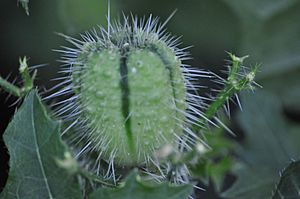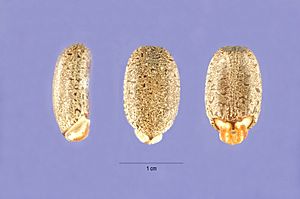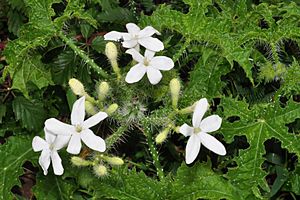Texas bullnettle facts for kids
Quick facts for kids Texas bullnettle |
|
|---|---|
 |
|
| Scientific classification | |
| Genus: |
Cnidoscolus
|
| Species: |
texanus
|
| Synonyms | |
|
|
The Cnidoscolus texanus, also known as Texas bullnettle, tread-softly, or mala mujer, is a plant that lives for many years. It is covered in tiny, stinging hairs. These hairs are like glass bristles and are found on the main stem, branches, leaves, and seed pods. When you touch them, they release a special liquid that causes pain.
If you touch the plant, you might feel a strong sting, burning, and itching that can last for hours. This plant grows naturally in the U.S. states of Texas, Arkansas, Kansas, Louisiana, and Oklahoma. It also grows in the northeastern part of Tamaulipas, Mexico.
The Texas bullnettle is a flowering plant that grows between 30 to 80 centimeters (12 to 31 inches) tall. It can spread out as much as 1 meter (3 feet) wide. It has pretty, white flowers that smell nice. In warmer areas, they can bloom all year. In cooler northern areas, they usually bloom from March to November.
This plant does not need much water, so it is great for xeriscaping (landscaping that uses less water). Many animals like this plant. Birds, bees, butterflies, and other insects are drawn to it. Rio Grande wild turkeys and mourning doves are known to eat its seeds.
People can also eat the seeds when they are ripe. In the past, Native Americans collected these seeds. Some people still enjoy them today. Each seed pod holds three seeds. These seeds are smooth, brownish-white, and about 1 to 2 centimeters (0.4 to 0.8 inches) long.
When the seeds are ready, the pod bursts open. This shoots the seeds away from the plant. You need to be very careful when collecting the seeds. It is a good idea to wear long pants, long sleeves, boots, and gloves. You can use tongs to pick the seed pods and drop them into a paper bag. Then, wait for the pods to burst inside the bag to get the seeds. People say the seeds taste good and have a nutty flavor.
What Does the Texas Bullnettle Look Like?
This plant lives for many years and has stems that grow upright or spread out. These stems come from a thick root system that can be up to 1 meter (40 inches) long and 20 centimeters (8 inches) thick. The plant has a milky sap and stiff, prickly stinging hairs.
Both the stems and leaves are green. The leaves are about 8 to 15 centimeters (3 to 6 inches) long. They are simple leaves, meaning they are not divided into smaller leaflets. They grow one after another along the stem. Each leaf has 3 to 5 deep cuts or lobes. These lobes often have rough or uneven edges.
The flowers grow in small groups at the end of the stems. Each flower is about 2.5 centimeters (1 inch) across. The flowers have five sepals (leaf-like parts that protect the flower bud) but no petals. The sepals are white, smell nice, and are covered with bristly hairs. Each flower has 10 stamens (the parts that make pollen) that are joined together. Male and female flowers grow in the same cluster but are separate. The fruits are prickly capsules, and each one holds three seeds.
This plant was first described in 1865 by Johannes Müller Argoviensis. He called it Jatropha texana. Later, in 1903, John Kunkel Small moved it to the Cnidoscolus group of plants.
What Happens if You Touch Texas Bullnettle?

Touching the Texas bullnettle, even just brushing against it, can cause a lot of pain. You might feel a burning, stinging, and itching rash that lasts for hours. The tiny hairs break off in your skin and release irritating liquids. These spines help the plant's liquids get into your skin.
In some rare cases, people might have a stronger reaction. This could be a skin infection or an allergic reaction. If you get stung, some people suggest putting a weak solution of ammonia on the area. You can also mix baking soda with water to make a paste. This paste can help stop the burning and itching because it makes the acidic liquid from the plant less strong.
You can try to remove the spines with adhesive tape. However, some advice suggests waiting 10 to 15 minutes for the spines to dry. If you press the tape on too soon, it might push more of the plant's liquid into your skin.



